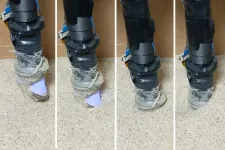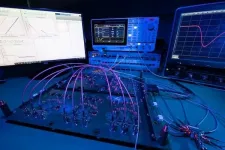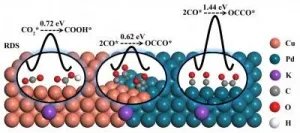(Press-News.org) Mitochondria are the cell's power plants and produce the majority of a cell's energy needs through an electrochemical process called electron transport chain coupled to another process known as oxidative phosphorylation. A number of different proteins in mitochondria facilitate these processes, but it's not fully understood how these proteins are arranged inside mitochondria and the factors that can influence their arrangement.
Now, scientists at the University of Copenhagen have used state-of-the-art proteomics technology to shine new light on how mitochondrial proteins gather into electron transport chain complexes, and further into so-called supercomplexes. The research, which is published in Cell Reports, also examined how this process is influenced by exercise training.
"This study has allowed for a comprehensive quantification of electron transport chain proteins within supercomplexes and how they respond to exercise training. These data have implications for how exercise improves the efficiency of energy production in muscle," says Associate Professor Atul S. Deshmukh from the Novo Nordisk Foundation Center for Basic Metabolic Research (CBMR) at the University of Copenhagen.
Traditional methods provide too little detail
It is already well established that exercise training stimulates mitochondrial mass and affects the formation of supercomplexes, which allows mitochondria in skeletal muscle to produce energy more efficiently. But questions remain about which complexes cluster into supercomplexes and how.
To better understand supercomplex formation, particularly in response to exercise, the team of scientists studied two groups of mice. One group was active, and given an exercise wheel for 25 days, and the second group was sedentary, and was not provided the exercise wheel. After 25 days, they measured the mitochondrial proteins in skeletal muscle from both groups to see how the supercomplexes had changed over time.
When scientists typically analyze how supercomplexes form, they use antibodies to measure one or two proteins per electron transport chain complex. But as there can be up to 44 proteins in a complex, this method is both time consuming and provides limited information about what happens to the remainder of the proteins in each complex.
As a result, there is a lack of detailed knowledge in the field.
Proteomics helps supercomplexes give up their secrets
To generate much more detailed data, the team applied a proteomic technology called mass spectrometry to measure the mitochondrial proteins. By applying proteomics instead of antibodies, the scientists were able to measure nearly all of the proteins in each complex. This provided unprecedented detail of mitochondrial supercomplexes in skeletal muscle and how exercise training influences their formation. Their approach demonstrated that not all of the proteins in each complex or a supercomplex respond to exercise in the same manner.
"Mitochondrial protein content is known to increase with exercise, thus understanding how these proteins assemble into supercomplexes is crucial to decipher how they work. Our research represents a valuable and precious resource for the scientific community, especially for those studying how the mitochondrial proteins organize to be better at what they do best: produce energy under demand,", explains Postdoc Alba Gonzalez-Franquesa.
The interdisciplinary project was a collaboration between the Deshmukh, Treebak and Zierath Groups at CBMR, and the Mann Group at the Novo Nordisk Foundation Center for Protein Research.
INFORMATION:
Over the years, robots have gotten quite good at identifying objects -- as long as they're out in the open.
Discerning buried items in granular material like sand is a taller order. To do that, a robot would need fingers that were slender enough to penetrate the sand, mobile enough to wriggle free when sand grains jam, and sensitive enough to feel the detailed shape of the buried object.
MIT researchers have now designed a sharp-tipped robot finger equipped with tactile sensing to meet the challenge of identifying buried objects. In experiments, the aptly named ...
A mathematical model which can predict landslides that occur unexpectantly has been developed by two University of Melbourne scientists, with colleagues from GroundProbe-Orica and the University of Florence.
Professors Antoinette Tordesillas and Robin Batterham led the work over five years to develop and test the model SSSAFE (Spatiotemporal Slope Stability Analytics for Failure Estimation), which analyses slope stability over time to predict where and when a landslide or avalanche is likely to occur.
In a study published in Scientific Reports, the research team was ...
Discovered by Victor Hess in 1912, cosmic rays, relativisitic particles that shower Earth, contribute a signicant part of the energy density in the universe and carries unambiguous informations on various astrophysical processes . Yet until now, origin of cosmic rays is still a mystery.
A key problem in understanding the origin of cosmic rays is the searching for the acceleration site up to or even beyond Ultra-high energy (UHE). Such extreme accelerators are dubbed as PeVatrons. However, composed of subatomic particles, such as protons or atomic nuclei, cosmic rays are charged and lose ...
Using intermittent electric energy to convert excessive CO2 into C2 products, such as ethylene and ethanol, is an effective strategy to mitigate the greenhouse effect. Copper (Cu) is the only single metal catalyst which can converts CO2 into C2 products by electrochemical method, but with undesirable selectivity of C2 product. Therefore, how to improve the conversion efficiency of Cu-based catalysts for reducing CO2 to C2 product has attracted great attention.
Recently, a research team led by Prof. Min Liu from Central South University, China designed a Cu-Pd bimetallic electrocatalyst possessing CuPd(100) interface which can lower the energy barrier of C2 product generation. The electrocatalyst was obtained through using ...
WASHINGTON--People who eat too many refined carbs and fatty meats for dinner have a higher risk of heart disease than those who eat a similar diet for breakfast, according to a nationwide study published in the Endocrine Society's Journal of Clinical Endocrinology & Metabolism.
Cardiovascular diseases like congestive heart failure, heart attack and stroke are the number one cause of death globally, taking an estimated 17.9 million lives each year. Eating lots of saturated fat, processed meats and added sugars can raise your cholesterol and increase your risk of heart disease. Eating a heart-healthy diet with more whole carbohydrates like vegetables and grains and less meat can significantly offset the risk of cardiovascular disease.
"Meal timing along with food quality are important factors ...
The farming of livestock to feed the global appetite for animal products greatly contributes to global warming. A new study however shows that emission intensity per unit of animal protein produced from the sector has decreased globally over the past two decades due to greater production efficiency, raising questions around the extent to which methane emissions will change in the future and how we can better manage their negative impacts.
Despite what we know about the environmental cost of livestock production, the global appetite for animal products such as meat, eggs, and dairy continues to grow. The livestock sector is in fact the largest source of manmade methane emissions globally, and these emissions are projected ...
A team of international researchers has found that the Tsimane indigenous people of the Bolivian Amazon experience less brain atrophy than their American and European peers. The decrease in their brain volumes with age is 70% slower than in Western populations. Accelerated brain volume loss can be a sign of dementia.
The study was published May 26, 2021 in the Journal of Gerontology, Series A: Biological Sciences and Medical Sciences.
Although people in industrialized nations have access to modern medical care, they are more sedentary and eat a diet high in saturated fats. In contrast, the Tsimane ...
UC San Francisco researchers have found a way to double doctors' accuracy in detecting the vast majority of complex fetal heart defects in utero - when interventions could either correct them or greatly improve a child's chance of survival - by combining routine ultrasound imaging with machine-learning computer tools.
The team, led by UCSF cardiologist Rima Arnaout, MD, trained a group of machine-learning models to mimic the tasks that clinicians follow in diagnosing complex congenital heart disease (CHD). Worldwide, humans detect as few as 30 to 50 percent of these conditions before birth. However, the combination of human-performed ultrasound ...
University of Virginia School of Medicine scientists have developed important new resources that will aid the battle against cancer and advance cutting-edge genomics research.
UVA's Chongzhi Zang, PhD, and his colleagues and students have developed a new computational method to map the folding patterns of our chromosomes in three dimensions from experimental data. This is important because the configuration of genetic material inside our chromosomes actually affects how our genes work. In cancer, that configuration can go wrong, so scientists want to understand ...
Hundreds of antibiotic resistant genes found in the gastrointestinal tracts of Danish infants
Danish one-year-olds carry several hundred antibiotic resistant genes in their bacterial gut flora according to a new study from the University of Copenhagen. The presence of these genes is partly attributable to antibiotic use among mothers during pregnancy.
An estimated 700,000 people die every year from antibiotic resistant bacterial infections and diseases. The WHO expects this figure to multiply greatly in coming decades. To study how antibiotic resistance occurs in humans' ...




